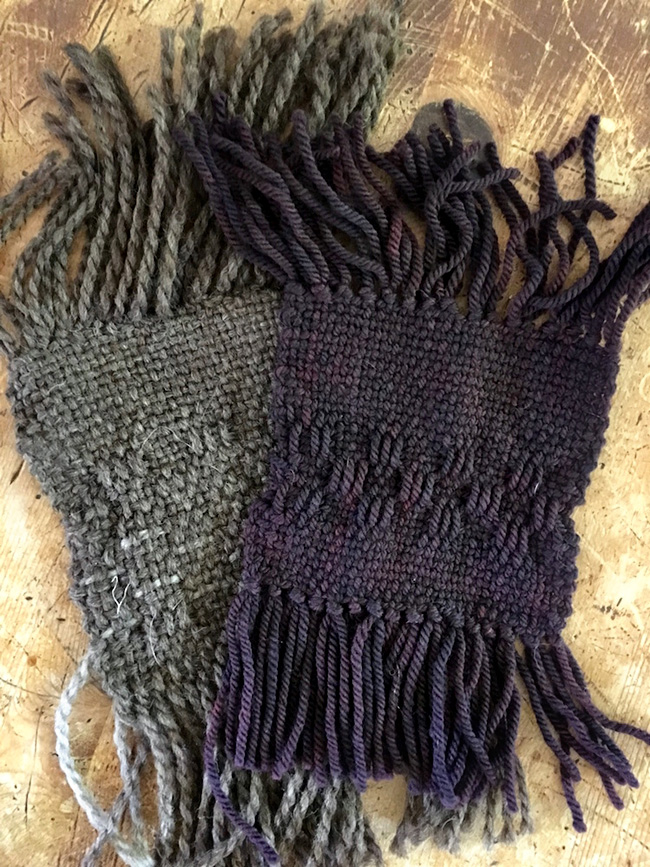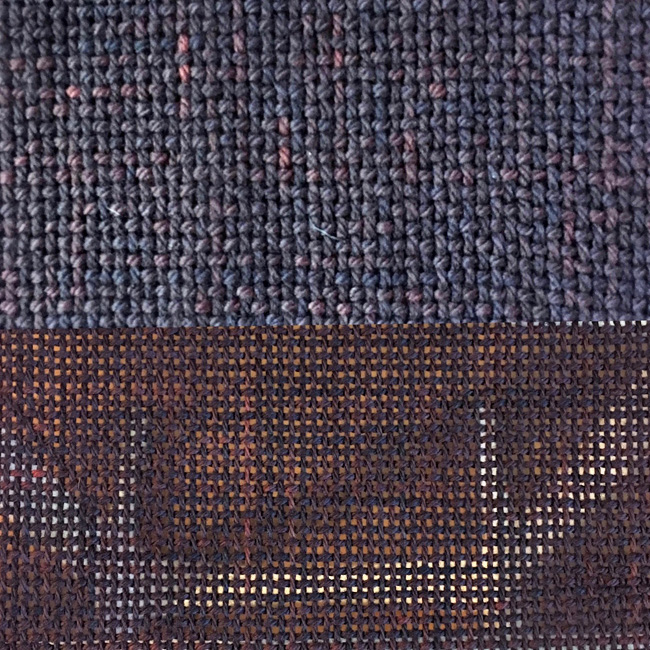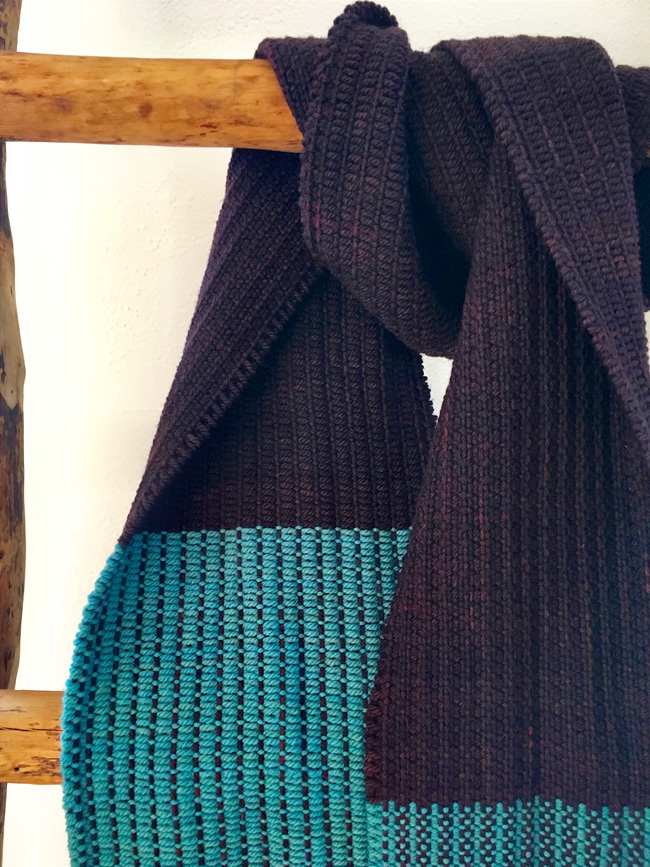Feature: Get Warped. Free weaving tutorial about how color appears in woven fabric by rigid-heddle loom expert Liz Gipson
Get Warped
Get Warped
Fuzzy, Smooth, Bouncy, Slack: The Many Faces of Wool
Wool is a much more variable product than, for example, cotton. Wool comes in many shapes and sizes and it takes some know-how to pick the right one for your given need. Over the next two issues, we will explore the wonders of wool as it relates to weaving. Since this is a magazine devoted to knitting, most of your stash is likely made up of wools on the soft, bouncy side, suitable for garments and accessories. We will start here.
In the next column, we will explore wools that are outside of this spectrum that lend themselves towards my favorite DIY genre, interiors. (It just so happens I have just released a new book, Handwoven Home, on the subject of interiors. I hope you will check it out.)
Fuzzy vs. Smooth
When it comes to wool and patterns, the same basic rules apply to weaving as they do to knitting—smooth yarns pop; fuzzy yarns blend.
Please note: This teacher got schooled. The original version of this article had some misinformation about Cascade Ecological Wool. I stated that it was a woolen yarn, when in fact it is a worsted yarn. The folks at Knitty graciously let me re-edit this information to set the record straight, and note to self—don't rely on secondary sources!

Take a look at the two swatches above. The swatch on the left is Cascade Ecological Wool, a “fuzzy” yarn. This yarn is made from a pooled wool comprised of many different breeds or cross-breeds, whose wool shares similar characteristics to achieve a uniform product. This wool is has a lot of crimp and spun with a relatively low degree of twist, giving it a soft look and hand that causes the pattern to recede into the cloth.
The swatch on the right is Sincere Sheep Bannock. It is a breed-specific wool made from Targee, a marvelous sheep with enough softness to please the knitter, and enough strength and length to wear well over time. The fiber, preparation, and construction give the yarn a pearlescent, clean look that makes the pattern pop.
Both of these yarns are worsted spun, making them great for warp. Worsted yarns are prepared so the fibers align and are all the same size, then spun using a worsted or semi-worsted spinning technique. This spinning style gives them a lot of strength that allows them to hold up well under the tension of the loom. Woolen yarns are prepared so that the fibers are jumbled and are spun in a way that that ensures there is a lot of air in the yarn, increasing wool's already-insulating properties. Woolen yarns tend to not be as strong as worsted.
Rarely will a yarn tell you if it is worsted or woolen spun. What's important for the weaver to know regardless of the style of yarn, is will it hold up under the tension of the loom. To learn more about a simple warp strength test, check out this video on my YouTube channel demonstrating the pinch and pull technique.
More Than Just Looks
Smooth yarns are not as prone to sticking to its neighbors in the warp. This isn't to say that you can't use fuzzy yarns—I've woven successfully with Cascade Eco many times—you just need to be mindful that you use an open sett.
Here is a real-world example: During a recent weave-along, the yarn used in the pattern wasn't available and I suggested that weavers use yarnsub.com to find a similar yarn. Yarnsub is designed with the knitter in mind.The second most popular match was a fuzzy yarn, and the pattern called for a smooth yarn. The weave-along project was a lace weave on a dense warp and some folks were having a terrible time getting a clean shed with the fuzzy yarn. So, while the yarn might sub well for knitters, it provided a challenge for weavers.
Bounce Factor
The other thing to assess is how much elasticity the yarn has. Let's look at our two yarns again relaxed (outer yarns), and under tension (inner yarns).
The fuzzy yarn compresses under tension, but not nearly as much as the smooth. This is due to both the characteristics of the fiber and the amount of twist in the yarn.

When the yarn is stretched out on the loom, you have to allow enough room in the sett and beat for it to rebound after it is off the loom. Let me repeat that, leave room for your yarn to move!
Below you'll see the Sincere Sheep yarn under tension on the loom (bottom), and after finishing (top). If you sett and beat the yarn too closely so it doesn't have room to bloom and expand off loom, your fabric might not have the drape you are looking for.

Further Reading
I recently wrote a blog post that went into great detail about wool yarn as it relates to weaving. There, I answered questions like is there a difference between weaving and knitting yarns (yes and no), and does superwash affect woven cloth (it does).
Pattern: Hybrid Bias Button Cowl
INTRODUCTION

This scarf is a great way to experiment with different pick-up patterns. Woven in mostly plain weave, the borders show off how some patterns look quite different on the front than they do on the back, giving you two looks for the price of one. Bouncy, sleek, and beautifully dyed, the yarn used in this project and featured above is made for weaving. The pick-up pattern pops off the ground.
I so admire Brooke Sinnes at Sincere Sheep, and others like her who are making extraordinary yarns with great care. The more you work with wool, the more you begin to appreciate the amazing yarns available to us today—I'm preaching to the choir, I know!
Brooke is a natural dyer and a weaver. She creates carefully sourced, domestically spun yarns, and dyes them in incredibly saturated palettes. If you read my column on color in the last issue, you know why I have a special place in my heart for naturally dyed yarns—they always harmonize with one another and never clash. A great choice for the color-shy weaver.
Another bonus about her line is all the yarns are worsted or semi-worsted, perfect for weaving for all the reasons stated above. Woolen spun domestic mills are a rarity, and Brooke is committed to supporting local farmers and domestic mills.
Getting to know your yarn maker enhances the experience of working with it. To learn more about this yarn and Brooke, check out her website at or listen to this interview on the Woolful podcast. It makes for fun weave-along entertainment.
 photos: Liz Gipson
photos: Liz Gipson
SIZE
One
FINISHED MEASUREMENTS
Width: 8 inches/20.5cm
Length: 63 inches/160cm cowl with 4 inch/10cm fringe
MATERIALS
Yarn
Sincere Sheep Bannock [100% Targee wool, 280 yd/4 oz skein];
![]() Warp: Urchin
Warp: Urchin
![]() Weft: Urchin and Hathor's Gem
Weft: Urchin and Hathor's Gem
Tools
![]() rigid-heddle loom with at least a 9-inch/23cm weaving width
rigid-heddle loom with at least a 9-inch/23cm weaving width
![]() 8-dent rigid heddle
8-dent rigid heddle
![]() 12-inch/30.5cm pick-up stick
12-inch/30.5cm pick-up stick
![]() 3 shuttles (2 for weft, 1 for scrap yarn to spread warp)
3 shuttles (2 for weft, 1 for scrap yarn to spread warp)
Project specifications
![]() Warp: 182 yd/166m Urchin (worsted-weight wool, 1,120 yd/lb, 13 wpi)
Warp: 182 yd/166m Urchin (worsted-weight wool, 1,120 yd/lb, 13 wpi)
![]() Weft: 28 yd/25m Hathor's Gem; 133 yd/122m Urchin (worsted-weight wool, 1,120 yd/lb, 13 wpi)
Weft: 28 yd/25m Hathor's Gem; 133 yd/122m Urchin (worsted-weight wool, 1,120 yd/lb, 13 wpi)
![]() Warp Ends: 75
Warp Ends: 75
![]() Warp Length: 87 inches/220cm (allows 18 inches/46cm for loom waste and take-up, most of the loom waste is used for fringe)
Warp Length: 87 inches/220cm (allows 18 inches/46cm for loom waste and take-up, most of the loom waste is used for fringe)
![]() Width In Rigid Heddle: 9 1/3 inches/23.5cm
Width In Rigid Heddle: 9 1/3 inches/23.5cm
![]() Sett: 8
Sett: 8
![]() PPI (Picks Per Inch or the number of wefts in an inch): 8 plain weave; 11 pattern
PPI (Picks Per Inch or the number of wefts in an inch): 8 plain weave; 11 pattern
DIRECTIONS
Warping
Warp the loom following the project specs.
Warp so you start and end in a hole.
If you are using the direct warping method, you have two choices: You can thread the slots in pairs, wind on the back beam and then remove one of the threads at the end and let it hang off the back beam, or you can cut the last pair at the peg being careful that the end connected to the warp is the same length as the rest of the warp ends.
For tips on warping, see the Spring + Summer 2015 Get Warped column.
Place the pick-up stick
If you are new to weaving pick-up, read my Spring + Summer 2016 Get Warped Column first before proceeding.
When using a pick-up stick, you only want to pick up threads in the slots. These threads move freely, making them easy to manipulate. The threads in the holes are restricted. If you pick them up, you will be unable to get a clean shed.
To make sure you only pick up the slot ends, place the rigid heddle in the down position so the slot threads are up.
Pick up the slot threads as follows: 2 up + [1 down/1 up] x 17 + 1 up
Weaving
Wind one shuttle with a smooth scrap yarn, one shuttle with Urchin and one shuttle with Hathor's Gem.
Start by weaving about 1 inch/2.5cm of scrap yarn to spread the warp evenly.
Plain Weave
Using Urchin, weave 5 inches/12.5cm being careful to maintain 8 picks per inch. I can't stress this enough. Take a look at that photo again of the fabric on and off the loom in the body of this column. You must leave room for your yarn to move. Gently press your yarn into place, instead of giving it a thwack with the rigid heddle.
For those of you with rigid heddles measured on the metric scale, you have an advantage over those of us use imperial measurements. Your rigid heddle at the worsted range measures about 7.5 dents per inch, giving you a slightly more open sett and a little bit more room for your yarn to move. You have to be extra careful to not over-beat your yarn.
End your plain weave on a down shed, so the pattern starts on an up shed.
Pick-Up Pattern
This is a variation of 3/1 lace with extra floats. It is a good pattern to use with bouncy wools. The floats show off the yarn, but since they are relatively short, they won't snag.
The pattern is woven as follows:
1. Up
2. Pick-up Stick
3. Down
4. Pick-up Stick
Weave 4 inches/10cm of the pattern using Hathor's Gem. It is still important to use a light hand when weaving the pattern.
End on a single Up pick.
Tips for Weaving Pick-Up
- The pick-up stick position is woven with the heddle in neutral and the pick-up stick tipped up on its edge.
- Depending on your loom, neutral may be easy or a pain to get in and out of. I leave my heddle hanging in front of the heddle block and then tip the stick on its edge. It speeds up the work.
- On the Down and second Pick-up Stick pass you will need to manually catch the selvedges, if you don't, you will notice that they aren't captured by the weft.
- Just like with knitting, if you haven't learned to read your fabric. it is easy to get lost when branching out into pattern. Here is a little tip to tell where you are. The pick that ties down the warp float is an up pick. If you are weaving along and your warp float doesn't seem to be getting tied down, you are probably not pushing the pick-up stick far enough to the back of the loom to get a clean shed.

Switch back to Urchin, and weave plain weave until you have about 9 inches/23cm open of warp left, approximately 53 inches/135cm. Weave 4 inches/10cm of the pick-up pattern with the Hathor's Gem, and finish off with 5 inches/12.5cm of plain weave.
Weave a few picks of scrap yarn to keep the weft yarn in place during finishing.
Sidebar Scarf Alternate Version

You can weave this scarf using the pick-up pattern entirely. It creates what I call muffler weight fabric—a thick cushy fabric that feels just like the yarn in the skein. Without compromising drape, the all-over pick-up pattern holds its ground around the neck and protects you from chilly fall winds, a harbinger of winter to come.
I wove this version reducing the first band of Urchin to 3 inches/7.5cm and increasing the Hathor's Gem bands to 10 inches/25cm. You need about 30% more weft to weave this version.
FINISHING
Remove the cloth from the loom by untying the knots.
Place the scarf on a flat surface and weight it so that you have some resistance to work with.
Remove the header a few inches at at time and tie off the fringe in 4-end bundles, except the center knot —the tenth knot from either edge—using only 3 warp ends. This will balance out the odd number of ends.
Fill a bathtub with warm water and a 1/8 cup of no-rinse wool wash, such as Soak. Lay the cloth in the tub flat and swish gently. Allow to soak for 20 minutes. Gently remove the fabric and press the water out of the cloth. Lay flat to dry.
Using a self-healing mat and a rotary cutter, trim the fringe to 4 inches/10cm. Trim all tails flush with the fabric.
Check out the Winter 2015 Get Warped column for information on finishing.
ABOUT THE DESIGNER
 Liz Gipson is a lover of yarn and that from which it comes – namely the mills and fiber-bearing critters and plants. She is the author of the newly revised Weaving Made Easy and has four video workshops for rigid-heddle weaving published by Interweave. Her new book, Handwoven Home, has just been released.
Liz Gipson is a lover of yarn and that from which it comes – namely the mills and fiber-bearing critters and plants. She is the author of the newly revised Weaving Made Easy and has four video workshops for rigid-heddle weaving published by Interweave. Her new book, Handwoven Home, has just been released.
Curious about the warped side of yarn? Visit Liz's website Yarnworker, for know-how and inspiration, or hang out with her @yarnworker on Facebook, Twitter, Instagram and Ravelry.
Pattern & images © 2017 Liz Gipson. Contact Liz




